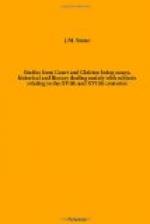II. A MISSING PAGE FROM THE IDYLLS OF THE KING
Although the Norte d’Arthur was one of the first books printed in the English language, the great semihistorical figure of Arthur, together with his Knights of the Round Table, and all their romantic exploits, had wellnigh died out of the memory of the English people when Tennyson published his Idylls of the King
The Morte d’Arthur was translated, according to Caxton, by Sir Thomas Malory, who took it “out of certain books of French and reduced it into English.” But it is no mere translation of the older romances, which Malory rather adopted as the basis of his work, moulding them to suit his more refined taste and fancy, much as Chaucer used Boccaccio’s tales, and Shakespeare a century after Malory adopted the plots and outlines of inferior playwrights.
Placed midway between the works of Chaucer and Shakespeare, the book, which has been aptly described as a prose-poem, is one of the happiest illustrations possible of the language, manners, modes of thought and expression prevalent in England in the fifteenth century. Chivalry was not yet dead, ideals were still cherished, the feudal system still obtained, Gothic architecture had not yet said its last word, Englishmen were papal to the backbone, and religion was a potent factor in their live, in spite of much that was harsh, crude, and violent. “Herein,” said Caxton, “may be seen noble chivalry, courtesy, humanity, friendliness, hardiness, love, friendship, cowardice, murder, hate, virtue, sin. Do after the good, and leave the evil, and it shall bring you to good fame and renommee.”
The Norte d’Arthur was finished in the ninth year of Edward iv., that is in 1470, and Caxton printed the first edition of the book in black letter, in 1485. Of this edition, now almost priceless, only two copies are known to exist, both of which are in private collections. One of these is in the United States, the other, slightly defective, is in the possession of Lord Spencer, who has also in his library at Althorp the only known copy of the second edition, printed in 1498 by Wynkyn de Worde, who took over Caxton’s presses at his death. Of the third edition (1529), also printed by Wynkyn de Worde, a copy is in the British Museum. It is incomplete inasmuch as the title, preface, and part of the table of contents are wanting.
The British Museum possesses two other copies, one printed by William Copland in 1557, the other a folio without date, published by East. All these editions are in black letter.




